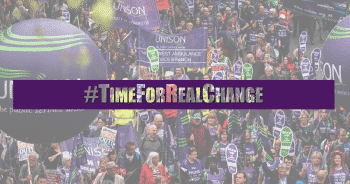

In a historic breakthrough the left has secured the majority of seats on the governing National Executive Council of Unison, Britain’s largest trade union. This is the first time the left has had control of the NEC and it gives them significant but limited powers, notably the right to endorse strike action.
Despite left divisions in the General Secretary elections giving an easy win to the Christine McAnea, the right wing candidate, Paul Holmes the branch secretary of Kirklees local government branch secured a very credible second place with 42,220 votes, 34% of those cast. His campaign, Time for Real Change, in an alliance with the Socialist Party, translated this momentum into 40 seats (out of 68) on the NEC.
The monthly meeting NEC can now start to undo some of the damage inflicted on 1.3 million Unison members, concentrated in the NHS and, local government and schools, over the past 25 years or more. Up till now, Unison has played a key role in undermining the fight against austerity in 2011, accepting cuts to pensions – straight after a huge one-day strike to oppose an almost identical package.
Inside the Labour Party, Unison also blocked the left wing leadership of Jeremy Corbyn and backed Keir Starmer’s leadership campaign last year. The union even appointed to posts in Labour’s HQ Emily Oldknow and John Stolliday, who we now know actively campaigned to undermine Labour’s 2017 general election bid. The left now has a real opportunity to reverse that trend.
However, the apparatus of the union has a lot of conservative officials who are used to the old culture of obstructing the lay membership in their industrial disputes and campaigns. A number of the old guard have also been involved in vicious witch-hunts against left activists and left branches. Most recently, for example, Karen Reissmann, a leading member in Manchester NHS, was suspended for publicizing a demonstration for… more pay for nurses! All of this must end and those days must never return.
However, the political divisions soon surfaced. The NEC elected a left wing presidential team to replace the previous team, leading to demagogic social media posts focusing on the gender of the president instead of the political positions. Paul Holmes was made president but banned from serving in the position because he remains suspended. Resolving this suspension – as well as the Karen’s – is clearly a priority.
Unison in many ways is like Labour. Dominated by the right who think they have a god given right to run the organisation. The left are seen as minority troublemakers. The new leadership will be seen as insurgents, a temporary aberration before the NEC elections in 2023 return the right to their natural position of power. The NEC will no doubt face certain elements of entrenched opposition from within the structures and the old guard of the Unison right.
We now have to work very hard to secure the gains, to launch campaigns that enthuse and energise members. For instance a proper industrial fight in the NHS over pay would help rebuild the failing health sector branches and bring new activists into the union.
But here the size of the problem starts to emerge. In the Health Service Group, which governs policy for hundreds of thousands of members, 24 out of 36 seats were elected unopposed and five were left vacant; it is dominated by the old guard right and has opposed real campaigning and a realistic claim of a 15% pay rise, which has been accepted by most other unions, even the Royal College of Nursing!
Similarly the left control of the NEC also offers a real chance to transform Labour Link, the structure within the union for members who pay into the affiliated political fund, which goes to Labour. Labour Link has always been dominated by the right because half of its national committee comes from the NEC; the left has only been able to win a few seats in regional elections.
With Labour Link elections coming up, there will be a huge fight and we need to ensure the election of more left Labour activists onto that committee. Even then – due to the cumbersome and purposefully arcane procedures – it will take a good year for any real change to take affect in terms of Labour Party Conference delegates or the two Unison representatives on the Labour Party NEC.
But another note of caution is necessary, an important one. Only 6.6% of members voted in the regional parts of the elections and less than 10% in the service groups section. As noted above, many parts of the NHS do not have an active and functioning branch or, as in the case of St Thomas’ and Guy’s in London, witch-hunted activists who tried to resuscitate the branch.
Branch activists must now co-ordinate real change from below, by campaigning for a united pay campaign for 15% across the public sector. Strong branches should reach out to weaker ones and those gripped by moribund right wing leaderships and place demands on the new NEC to lead the fight – and defend members whenever they are attacked by regional officials. If necessary, the new NEC should overrule the right wing bureaucrats and call co-ordinated strikes across the different sectors.